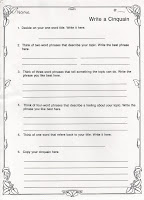There are many ways to learn about authors - the web is full of lots of great ideas.
Here are a few of the projects I did with my students over the years:
1. Set up AUTHOR OF THE MONTH Area in the classroom with a poster depicting the author's books, various books the author wrote, and an audio tape of the author telling about their experiences.
 2. At the end of each month students would draw a picture showing their favorite book they read that month by the author.
2. At the end of each month students would draw a picture showing their favorite book they read that month by the author.
Questions to guide the experience:
What type of books does this author write?
Who are the characters? Are the main characters the same or different in the books that you found/read?
Is the setting similar in all or some of the books? If so, why do you think the author chose this particular setting?
Are there particular messages that the author wants to voice?
Are the characters similar? Compare and contrast the main characters in 2 of the books (short stories).
If you put this author’s books in chronological order by copyright date, does a pattern emerge? If so, how might you characterize this author’s writing development or sequence?
Use an encyclopedia to look up information about the author, or see if there is a biography (or auto biography) for this author. What in the author’s life might have influenced his or her writing? What was happening historically in the author’s home country at the time of his/her major works?
Did the author publish works in more than one genre?
What do the author’s books tell you about the author’s culture?



















































